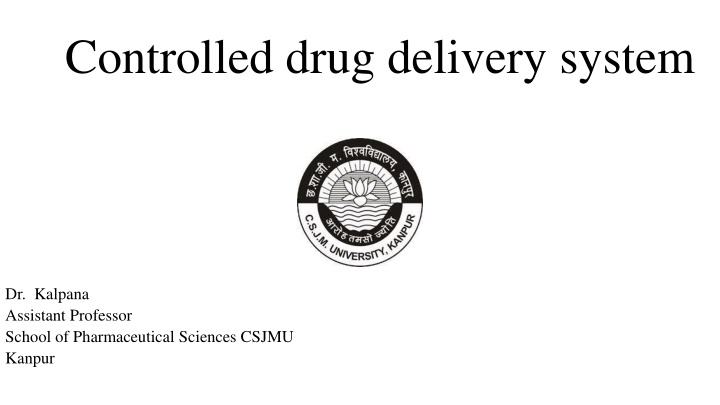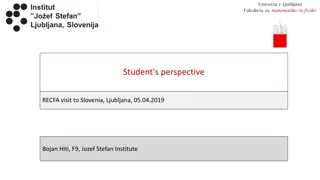
Controlled Drug Delivery Systems
Controlled Drug Delivery Systems (CDDS) play a crucial role in altering the pharmacokinetics and pharmacodynamics of bioactives for enhanced safety, efficacy, and patient compliance in pharmaceutical formulations. This article explores the advantages of CDDS over conventional drug delivery methods, such as improved bioavailability, targeted drug release, and protection from premature metabolism. Discover the key parameters in plasma drug concentration-time profiles and the benefits of modified release dosage forms. Dive into the concept of Controlled Release and Defined Drug Release Systems for optimal drug delivery outcomes.
Download Presentation

Please find below an Image/Link to download the presentation.
The content on the website is provided AS IS for your information and personal use only. It may not be sold, licensed, or shared on other websites without obtaining consent from the author. If you encounter any issues during the download, it is possible that the publisher has removed the file from their server.
You are allowed to download the files provided on this website for personal or commercial use, subject to the condition that they are used lawfully. All files are the property of their respective owners.
The content on the website is provided AS IS for your information and personal use only. It may not be sold, licensed, or shared on other websites without obtaining consent from the author.
E N D
Presentation Transcript
Controlled drug delivery system Dr. Kalpana Assistant Professor School of Pharmaceutical Sciences CSJMU Kanpur
Introduction Plasma concentration time Profile. conventional vs CDDS Advantages of CDDS Characteristics making drug suitable for CRDDS formulation
Plasma Drug Concentration-Time Profile : A direct relationship exists between the concentration of drug at the biophase (site of action) and the concentration of drug in plasma. Two categories of parameters can be evaluated from a plasma concentration time profile Pharmacokinetic parameters Pharmacodynamic parameters.
Pharmacokinetic Parameters: 1. Peak Plasma Concentration (Cmax) : dose, absorption rate, elimination, (mcg/ml) The peak plasma level depends decides intensity of action. 2. Time of Peak Concentration (tmax) onset time and onset action 3. Area Under the Curve (AUC) mg/ml xhrs
Pharmacodynamic Parameters 1. Minimum Effective Concentration (MEC) 2. Maximum Safe Concentration (MSC) 3. Onset of Action 4. Onset Time 5. Duration of Action 6. Intensity of Action 7. Therapeutic Range 8. Therapeutic Index
The basic idea behind controlled drug delivery concept: Is to alter the pharmacokinetics and pharmacodynamics of bioactives either by modifying the molecular structure Physiological parameters by an alternative route of administration or by using novel drug delivery systems . The primary objective of CRRDS is to ensure safety and enhance efficacy of drug with improved patience compliance
Limitation of conventional Advantages of Modified Release dosage form Controlled defined drug release Poor absorption from site of administration Target specificity Premature excretion from body Cost effectiveness high Drug protection from chemical /enzymatic hydrolysis Premature metabolism of drug Improve compliance Poor drug bioavailability Poor patient compliance Improved bioavailability Improved convinience
Sustained Release Drug release for extended period of time DR follow first order kinetic Not maintain constant drug levels in blood Do not contain mechanism for localization of drug at active site Designed to slow the rate of release of the active ingredients in the GIT Controlled release Release drug for specific time DR follows zero order kinetics Maintains constant drug level in blood Promotes localization of drug The release is at pre determined rate
ADVANTAGES OF CDDS Reduced dose Improved stability of drug Less fluctuation of drug levels Improved drug efficacy Reduced overall cost Reduced GI side effects Reduced Dosing Frequency Better compliance
Disadvantages Dose dumping Retrieval is difficult in emergency Poor invitro invivi correlationship Dose adjustment is difficult Stability issues High cost of formulation Reduced flexibility for physician Need additional patient education
Rational Behind CDDS Less exposure to drug. Minimal fluctuation/Improved compliance Reduced drug toxicity. Minimal side effect.
selection of drug candidiate for CRDD Very short or long half life High first pass metabolism Poor absorption through GIT Low aqueous solubility Large dose size Narrow therapeutic index
Drug selection criteria for CDDS Physiochemical properties Aqueous solubility : X Furosemide, diltiazem, griesiofulvin Molecular weight/ size X :eg Protein peptide Ionization : hexamethonium Absorption mechanism Stability: X erythromycin , riboflavin erythromycin Ko/w (log p value ) pKa and pH
Pharmacokinetic properties Absorption rate constant Ka = 0.17- 0.23 /hr ( Ka>>>>>> Kr) X Phenytoin Dicoumarol Elimination Half life Depends on Vd, Cl following dose dependent kinetic are not suitable candidiate. Eg penicillin (45 min ) digoxin 40 hrs Metabolic Rate Protien binding : Amidarone High protein bound Pharmacodynamic Properties Dose Therapeutic range Therapeutic index Pk/ Pd relationship Absorption window






















